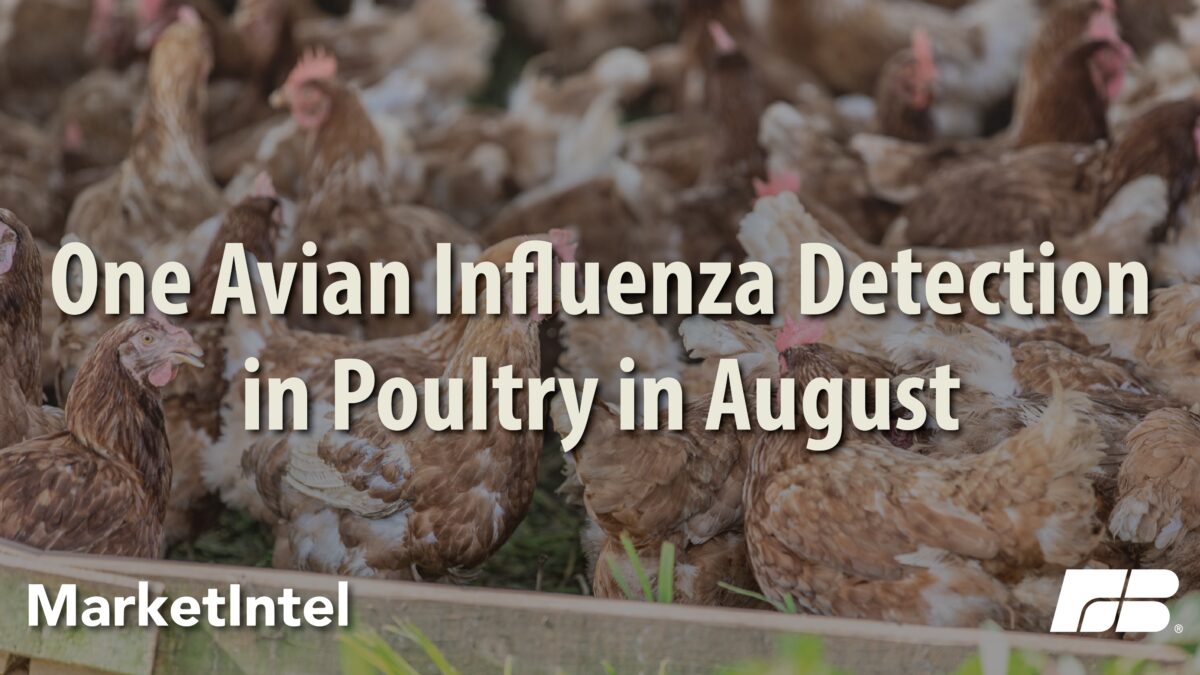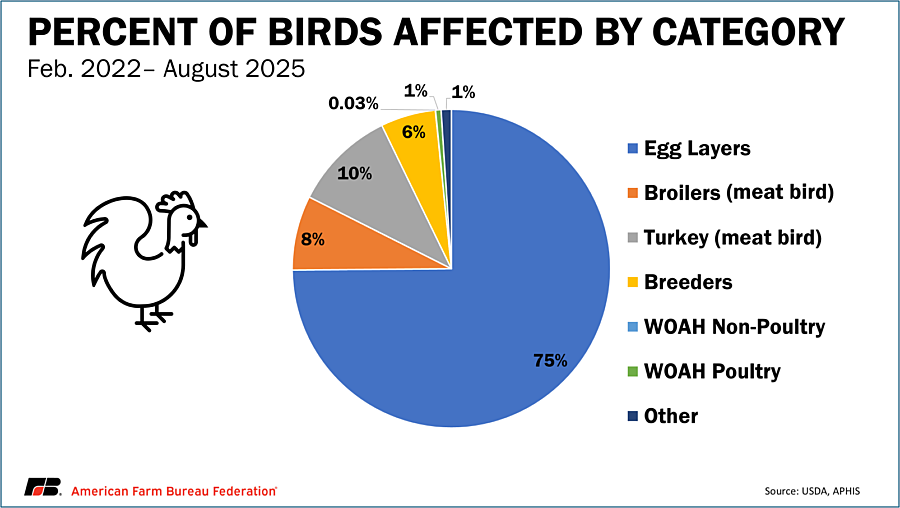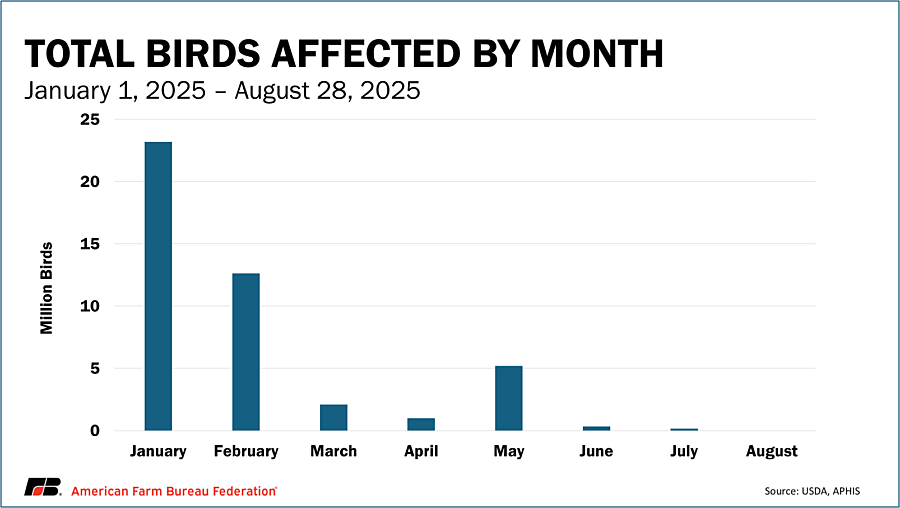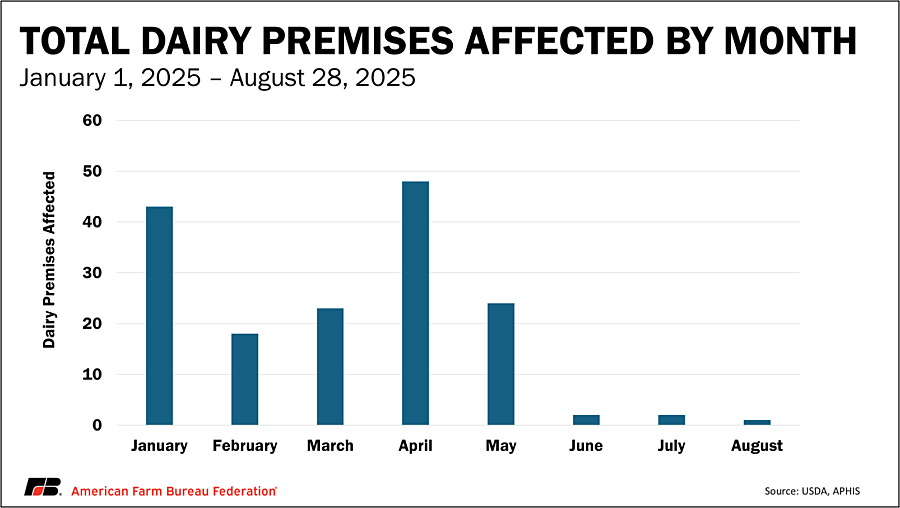Avian Influenza Detections Drop, But Fall Migration Looms

Bernt Nelson
Economist
Over 175 million birds and 1,075 dairy herds have been affected by the current strain of Highly Pathogenic Avian Influenza (HPAI) since it began in February 2022. Detections of HPAI in both poultry and dairy cattle have slowed over the summer months with just one detection in commercial poultry flocks and one dairy herd detection in the last 30 days. This Market Intel provides an update on the status of HPAI and what to watch for as the fall migration season approaches. Migratory birds moving south along flyways are the most likely to spread HPAI, which survives better in cool conditions, making fall a likely time for HPAI flare-ups.
The Outbreak
Poultry
Since the first detection of the current HPAI strain on Feb. 8, 2022, there have been 1,710 detections of HPAI in 50 states and one territory, affecting nearly 175 million birds. The virus caused the most production loss in turkeys and egg layers due to their close proximity to the Central and Pacific flyways where HPAI is more prevalent. Broiler flocks (chickens raised for meat), while impacted, are raised further from those flyways and have benefited from lower infection rates.
Dairy Cattle
The first detection of HPAI on a dairy farm occurred in March 2024. Since then, HPAI has been confirmed in 1,075 dairy herds in 18 states. Over 72%, or 777, of premises with positive detections were in California. Factors like geographic location and shared employees, equipment and vehicles are risk factors for spreading the virus among dairy farms. The last detection of HPAI for dairy and poultry was a dairy herd that tested positive in California on Aug. 1, 2025.
Impacts
Eggs
Commercial egg laying farms account for over 130 million, or 75%, of the birds affected by HPAI. This significantly reduced the supply of eggs, especially for states that only allow the sale of eggs from cage free production practices, causing egg prices to rise to record levels on several different occasions from 2022-2025. The slowdown in HPAI detections over the summer allowed egg prices to decline. The national average retail price for a dozen eggs in July was $3.59 per dozen, down 40% from the record of $6.22 per dozen set in March of this year.
USDA’s most recent Chickens and Eggs report, published on Aug. 22, estimates egg-type chicks hatched in July totaled 58.2 million, up 4% from July 2024. Eggs in incubators were 56.2 million, up 9% from last year. This indicates that the egg industry is recovering, and inventories are strengthening as fall approaches. It’s important to note that a single detection on a large operation can have big impacts. This is another reason why egg prices are particularly vulnerable to detections of HPAI.
Broilers (Raised for Meat)
As stated earlier, broiler chickens have been affected much less than egg layers and turkeys in this strain. This is largely because most U.S. broiler production takes place away from the Central and Pacific flyways where HPAI is most prevalent. However, broiler flocks have not gone unaffected. A total of 13.2 million broilers have been affected, accounting for 7% of the total birds affected by HPAI since 2022. USDA projects broiler production will be 47.7 million pounds, up 1.6% from 2024. While higher weights are partially behind the increase, continued strength in broiler chick hatch numbers will provide a cushion if HPAI detections show up in broiler flocks this fall.

Note: WOAH (World Organisation for Animal Health) Poultry refers to all birds kept in captivity for the production of any commercial animal products, or for breeding for this purpose and all birds used for restocking supplies of game or for breeding for this purpose, until they are released from captivity.
WOAH Non-Poultry refers to birds not fitting the WOAH definition of poultry, such as those in private households, that do not pose the same level of commercial risk.
Turkey
Over 18 million commercial turkeys have been affected by HPAI since 2022, accounting for about 10% of all poultry birds in this outbreak. USDA will release its annual Turkeys Raised report on Sept. 26. This report contains annual data for turkeys raised in the U.S. in 2025. Turkeys are the number two category impacted by HPAI and were the only commercial poultry affected by HPAI in August. The number of turkeys raised has fallen dramatically over the last 15-20 years, dropping by 25% from 275 million in 2008 to just 205 million turkeys in 2024. Fewer turkeys raised means the industry is more vulnerable to HPAI and other diseases. While there has been only one recent detection of HPAI in turkey flocks, avian metapneumovirus has also been driving production lower.
Dairy
HPAI in dairy herds has also slowed over the summer months with only five dairy herds testing positive between June 1 and Aug. 28. The HPAI strain affecting dairy cattle is genetically different from the strain spread by wild birds. This strain mostly affects lactating dairy cattle. Symptoms of the virus include reduced milk production; thicker, concentrated or colostrum-like milk; reduced feed consumption; abnormal or loose feces; lethargy; dehydration; and fever. Most cattle recover after a couple of weeks and mortality rates are very low, with deaths occurring in only about 2% of affected cattle. A recent study by Cornell University researchers estimated economic losses due to decreased milk production, mortality and early herd removal were $950 per infected cow. Even if the cow makes a full recovery, farmers face an average of $367 in milk losses per infected cow, according to the study.
American Farm Bureau Federation called on USDA to help dairy farmers offset their risks of full participation in the response to HPAI. As a result, USDA is now providing financial assistance to eligible dairy farmers for any milk losses due to HPAI in dairy cattle. Since USDA began accepting applications on July 1, 2024, over $390 million has been paid out to 989 processed applications through USDA’s Emergency Assistance for Livestock, Honeybees and Farm-Raised Fish Program (ELAP).
Conclusions
Detections of HPAI in both poultry and dairy cattle have slowed over the summer months,allowing stakeholders in both industries time to improve biosecurity and get ready for the upcoming season. USDA offers two free voluntary biosecurity assessments to help farmers get ahead of any potential HPAI threats. One focuses on wildlife risk mitigation and the other on general biosecurity improvements. USDA had completed 948 biosecurity assessments as of June 26 and more have been completed since then. These assessment-driven biosecurity improvements will soon be tested as migratory birds begin their annual trek south for winter shortly and the risk of HPAI detections increases.
Top Issues
VIEW ALL

